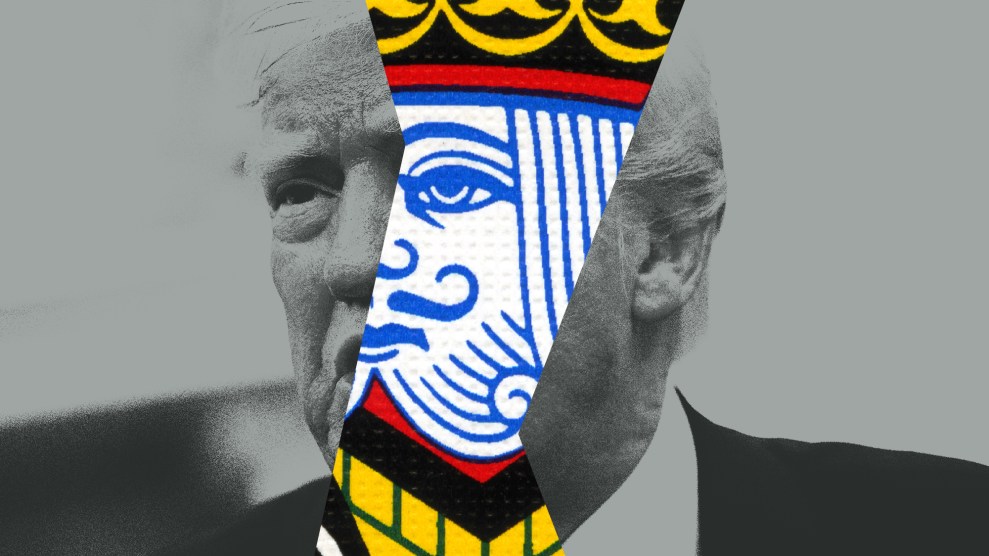The Trump administration is investigating whether former President Joe Biden was so enfeebled that his advisers secretly ran the country on his behalf. House Republicans and Trump’s obsequious new pardon attorney are likewise probing whether Biden’s aides issued pardons without his knowledge. “Although the authority to take these executive actions, along with many others, is constitutionally committed to the President,” stated Trump’s executive order initiating the investigation, “there are serious doubts as to the decision making process and even the degree of Biden’s awareness of these actions.” If Biden wasn’t aware of them, the order states, the actions may be void.
Trump’s indifference to the job is the modern incarnation of a problem that defenders of a strong presidency have always ignored.
The country is only starting to understand the extent of Biden’s decline, with the truth somewhere between the fully-capable Biden his White House insisted on and the Weekend at Bernie’s presidency Trump has conjured. But the ongoing investigations by Trump and his allies must inevitably reckon with a separate but important question: What exactly is the job of the president, and how much incapacitation or delegation is too much?
It is ironic that these questions are being pressed so forcefully by Trump, who himself is uninterested in much of the work of governing. The irony deepens when you consider that Trump and his administration are seizing power under the theory of the “unitary executive,” the idea that a single person, the president, embodies the entire executive branch and must have the power to hire, fire, and direct executive agencies as he desires. This theory so clearly animates the Trump administration that it is infused in the text of the executive order on the Biden investigation, especially in a section that makes an issue of Biden’s use of an autopen. The president, it states, “as the unitary head of the executive branch, holds tremendous power and responsibility through his signature… The Nation is governed through Presidential signatures.” That is not how American government is supposed to operate, but, as Trump’s own executive order concedes, the fantasy of unchecked presidential power only works if the president is actually in charge.
The Supreme Court, now dominated by proponents of a unitary executive, is seizing on Trump’s illegal power grabs to further etch the theory into Constitutional law. From allowing Trump’s illegal firings of independent commissioners to take effect to greenlighting the Department of Government Efficiency’s access to troves of Social Security data in likely violation of the law, the court’s GOP-appointed majority is a embracing a vision of executive authority that overrides Congress’s laws and grows the powers of the White House. At the very moment that the country is grappling with whether the last president was significantly diminished, followed by a president with a clear disdain for much of the job, the courts continue to hand the office increasingly king-like powers on the theory that the president alone must run the show.
“The overall problem is that the unitary executive theory is a fiction,” says Christine Chabot of Marquette University Law School. “Unitary executive theory seems to think that, at its extreme, the president is in control of all policy decisions made in the executive branch. And that’s just an impossibility. It has been since day one. George Washington could never have controlled all the executive branch decisions that were being made when he was president, and it’s even more true now.”
During Trump’s first term, it was well known that the president didn’t like to read, thus limiting his intake of memos and policy briefs. This time around, Trump’s disengagement may be worse. In May, Politico reported that Trump had only sat for 12 briefings with intelligence officials since his inauguration, a dangerous abdication compounded by the fact that he doesn’t appear to read the intelligence briefs that are produced for him five days a week.
There are many such signs of Trump’s detachment. In an ABC interview marking the first 100 days of his second term, Trump deferred the question of whether immigrants he has condemned to a notorious El Salvadoran prison were owed due process, saying, “They get whatever my lawyers say.” Of Kilmar Abrego Garcia, the man his administration mistakenly sent there, Trump appeared to believe his own administration’s false propaganda that Abrego Garcia had tattooed the transnational gang name “M-S-1-3” on his knuckles. The episode raised the question of whether Trump is informed by his aides or deceived by them.
Musk’s role suggests Trump is not fully in charge—not because he is incapable of leading, but because he just doesn’t want to.
Then there is Elon Musk. In the first months of this administration, the president outsourced to the world’s richest man the project of dismantling his own government. He did this, reportedly, without keeping tabs on the operation and possibly misunderstanding its mission. Of Musk’s promise to cut $1 trillion in spending, Trump recently wondered, “Was it all bullshit?”
According to an astonishing Wall Street Journal report, Musk “often surprised senior administration officials with his decisions” and “made dramatic government cuts without consulting others, including White House chief of staff Susie Wiles.” Trump’s top aides learned second-hand what DOGE was doing, and Musk made “cuts at the Health and Human Services Department that some in the West Wing disagreed with.” There is surely an element of political opportunism in these leaks, distancing Trump from Musk’s most unpopular actions as he slinks away from Washington. But they are also an extraordinary account of a president who is not fully in charge—not because he is incapable of leading, but because he just doesn’t want to.
The idea of an incapacitated or uninterested president whose administration is surreptitiously run by his aides gnaws at the logic of the unitary executive theory. The theory rests on the thin reed of two clauses in Article II of the Constitution, which vest executive power in the president and charge the president with ensuring the laws are faithfully executed. To add meat to these bones, Chief Justice John Roberts, whose judicial opinions have given constitutional life to the unitary executive theory, has also adopted a long-running argument that endowing the president with more power over the executive branch leads to more democratic accountability.
This is the constitutionalization of the general idea that, as President Harry Truman put it, the buck stops at the Resolute Desk. If every member of the executive branch operates according to the president’s will and at the president’s pleasure, then voters know who to blame when something goes wrong. The executive power “acquires its legitimacy and accountability to the public through ‘a clear and effective chain of command’ down from the President, on whom all the people vote,” Roberts wrote in 2021.
“The functional argument is its democratic responsiveness,” explains New York University law professor Noah Rosenblum. “That requires some amount, at least theoretically, of presidential involvement, engagement, invigilation…that’s supposed to go along with a sense that the president is genuinely seeing what’s going on.”
Roberts himself has flicked at the necessity of an active executive. The founders, he wrote in his 2024 decision granting presidents broad criminal immunity, envisioned a “‘vigorous’ and ‘energetic’ Executive… for a ‘feeble executive implies a feeble execution of the government.’” While Alexander Hamilton, whom Roberts quotes in that passage, wrote those words to argue for a single president over an executive branch run by multiple people, the need for a sole point of authority—much less an energetic one—is theoretically incompatible with a tired president whose aides run the show. Roberts’ further justified presidential immunity as a critical condition for the president to execute his duties “fearlessly.” The further you get from a vigorous president making all the decisions, the less important immunity theoretically is.
On the other hand, the legal justification for the president’s powers—those all-important lines from Article II—requires neither an energetic president, nor does it frown upon inordinate amounts of delegation. The theory “is about the original meaning of the Constitution,” originalist scholar Michael Rappaport of San Diego University School of Law wrote in an email. “It does not mean that it is good policy,” though he says he believes it is. While “abuses of the presidency by presidential staff and infirm presidents are problematic and in many cases illegal,” he added, “illegal actions by some is not necessarily a reason to depart from the constitutional rule.”
The need for a sole point of authority is theoretically incompatible with a president whose aides run the show.
Because it is impossible for one person to make every decision, “there is a more realistic version of the accountability idea of the unitary executive theory, where the President is in control at least of the larger, more important decisions,” says Chabot. “The problem is the Constitution doesn’t have great accountability mechanisms” after a president’s abdication goes beyond that point and the president is too checked out.
Given their professed belief in democratic accountability, Roberts and fellow backers of the unitary executive theory might argue that the antidote to a president who won’t or can’t keep up with the job is small-d democracy itself; that the people might see an enfeebled president and so elect someone else. This is, in fact, what doomed Biden’s shot at a second term.
But the mechanisms for democratic accountability are inadequate. The president can win with a minority of the popular vote, as happened in 2000 and 2016, while a second-term president will never face voters again. The Supreme Court’s own disdain for voting rights legislation, its approval of widespread gerrymandering, and its gutting of campaign finance regulations, belies the increasingly empty promise of democratic course correction. Thus, Roberts and the Republican legal movement envision an engaged president, but don’t actually provide an off-ramp when we don’t get one.
Jeremy Rabkin, professor emeritus at George Mason University’s Antonin Scalia Law School, doesn’t believe that Biden’s or Trump’s incompetencies raise fundamental questions about unitary executive theory. Rabkin wonders whether Biden was fit enough for the job even in his earliest months as president based on the chaotic US withdrawal from Afghanistan and its aftermath. “But I don’t see any remedy for this—apart from expecting journalists to highlight the problem and move public opinion to demand some change at the very top,” he wrote in an email. “It wouldn’t be sensible to say, ‘The President should not be in charge of the military, because he might be too gaga to give sound directives to them.’” In other words, the constitutional grant of ultimate responsibility in the president should not be turned off just because some presidents rely too heavily on their staff.
Unitary executive theory is built around the platonic ideal of a president—active and engaged at every level: responsive to the people, and naturally lawful. But presidents are not always vigorous, and they cannot possibly be on top of everything happening in the executive branch. Nor are they immune from the allure of criminal conduct—it’s no accident that the modern unitary executive theory was first cooked up by President Richard Nixon’s lawyers to shut down the Watergate investigation.
“These guys profess to worship the founders of the Constitution, and yet the very premise of that document was that we have to design something for fallible people who are not perfect, and who get old and die and lose their energy,” says Rosenblum. “If men were angels, none of this would be necessary.”
The Republican legal movement envisions an engaged president, but doesn’t provide an off-ramp when we don’t get one.
While the unitary executive theory operates under the presumption of an ideal president, it incentivizes a far worse, even criminal, version. It assigns the president powers that Congress cannot touch, transforming our system of government from a power-sharing arrangement between all three branches to one in which the president will usually win out over the other two. In doing so, it promises democratic accountability in theory, but removes the Constitution’s central accountability mechanisms.
By reinventing the presidency as an Oval Office king, the theory also recreates one of monarchy’s pathetic incarnations: a hapless king whose close ministers rule the realm. It’s not hard to imagine this situation. Again take Musk, whose hatchet job across the federal government breached authorities reserved for the cabinet secretaries. The Supreme Court is blessing Musk’s actions, even as reporting makes clear Trump wasn’t even aware of some of what he was doing. This is, of course, the exact situation Republicans contend occurred under Biden.
“This is a larger topic, one we all need to reckon with when it comes to the American presidency today,” Jake Tapper, who co-wrote a recent book that reported on how Biden’s aides concealed his decline, told the New Yorker last month, “and the degree to which one person is bestowed with so much power, and surrounded by individuals whose own power depends on that person maintaining power, regardless of whether or not it’s good for the White House, the party, or the country.”
That a president might become senile, incapacitated, or simply uninterested in the job is not an unforeseeable problem for the unitary executive theory. In fact, it is baked into its history from the very beginning. The unitary executive theory claims its legal roots and historical tradition from a 1926 Supreme Court decision called Myers v. United States. The case arose when Frank Myers, a postmaster in Oregon, sued for back pay after he was illegally removed from his post during President Woodrow Wilson’s administration. But Chief Justice William Taft, a former president himself, wrote a decision that blessed the firing, seizing on the case to create a more powerful executive. Republican lawyers resurrected the case in the 1980s when they invented the unitary executive theory. It’s endorsement of the president’s broad removal power continues to lay the theory’s legal foundations, from Justice Anonin Scalia to Roberts. But this case undergirding the idea of an all-powerful president most likely came about because of an incapacitated one.
The origins of the Myers case, and exactly why Myers was removed in an illegal manner, are mysterious. At the time, by law, presidents could only remove postmasters by having the Senate confirm a new one. But Myers was fired without Wilson nominating any replacement. As Rosenblum and Andrea Katz, a professor at the Washington University School of Law in St. Louis, detailed in a 2023 law review article, the likeliest explanation is that Myers was fired by Wilson’s underlings while the president was convalescing.
Wilson suffered a severe stroke in October 1919, and in the months that followed his wife, Edith, took charge of the White House. While Wilson’s doctor, a close friend, fended off inquiries about the absent president’s health, Edith and his closest advisers functionally ran the country. “In the period surrounding the Myers affair, Wilson was rarely lucid and was prone to impulsive action and erratic, unmoored thinking,” Katz and Rosenblum write. It was the first lady who decided what was brought to the president’s attention, screening out all but the most pressing issues. At the time of Myers’ firing, Wilson’s limited faculties were focused on the League of Nations. It seems unlikely that the question of who should take a new patronage job in the Postal Service would have reached his bedside.
As Reagan lawyers, Justices Roberts and Alito helped increase his powers just as he was shrinking from the job.
“This would explain why Wilson did not seek to remove Myers by nominating a replacement: He was in no position to nominate one,” Katz and Rosenblum write, theorizing that “Myers’s removal may have been the accidental improvisation of a group of presidential advisers acting without a plan.” So with the Meyers decision, the Supreme Court authorized the presidential removal of an officer that Wilson himself may never have actually removed.
But on a deeper level, the irony of the case is that it provided the basis for a fundamental shift toward a president-controlled government based on the possibly falsified actions of an incapacitated president’s aides. The question of Biden’s ability to run the government and Trump’s apparent indifference to the job do not reflect a new challenge to the unitary executive theory—they are simply the modern incarnations of a problem that defenders of a strong presidency have conveniently ignored from the beginning.
The historical ironies don’t end there. Some sixty years after Wilson’s incapacitation, it was lawyers for President Ronald Reagan who first used Myers to push the bounds of presidential power and piece together the legal skeleton of the unitary executive theory. Scalia, a Reagan appointee, joined the Supreme Court in 1986 and, just two years later, penned a landmark dissent that conservative law professors used as the backbone of their new unitary executive theory. All this was happening at a time when Reagan, the oldest president until Trump and Biden, may have been suffering from early symptoms of Alzheimer’s. At the very least, perhaps like Biden, age was taking its toll while on the job.

There is an unsettled debate about when Reagan’s Alzheimer’s symptoms began, and whether it diminished his ability as president. Journalist Lesley Stahl has written about an Oval Office meeting she had with Reagan in 1986, where she found a frail and silent man with a vacant stare. She was mentally preparing a broadcast to tell the country that the president was senile when Reagan seemed to “recover,” leaving her to decide she “couldn’t report on my observations.” Stahl later came to the conclusion that Reagan’s wife and aides were covering up his decline.
Columnist Max Boot, who published an authoritative Reagan biography last year, said he had not encountered evidence of Alzheimer’s symptoms while he was president, but that his advanced age—Reagan left office at 77—meant that aides were running the show. “A lot of the administration decisions were being made by [National Security Adviser] Colin Powell, [Defense Secretary] Frank Carlucci, and [Secretary of State] George Schultz,” Boot told the Washington Post, “who were just meeting among themselves and presenting the president with fait accomplis.”
The Iran-Contra Affair, in which the Reagan White House’s National Security Council smuggled arms to Iran and used the proceeds to illegally fund the Contra uprising in Nicaragua, provides more evidence of the problematic combination of a declining president and an empowered executive. Reagan’s aides essentially turned the NSC, a presidential advisory council, into an extra-legal arms dealing operation, professing that executive power exempted them from Congress’ dictates—yet they did so in the name of a president who wasn’t fully aware of the scheme. Roberts and Justice Samuel Alito, who started out as young Reagan administration lawyers, helped to increase Reagan’s powers just as the president himself was shrinking from the job. Today, they are implementing unitary executive theory on the court.
The question of how to square an all-powerful president with the reality of an absent one is particularly salient as the two oldest presidents ever collide with the Supreme Court’s still-unfolding decision to turn this theory of expansive presidential powers into our new system of government. The justices themselves could conceivably be asked to reconcile the mess they’ve made.
As Trump-backed investigations into Biden and his inner circle unfold, it’s possible that the Trump administration might declare certain of his actions or pardons void, or even seek to prosecute former Biden aides, on the theory that they criminally usurped the power of the president—whether the evidence warrants it or not. Such actions would inevitably end up in federal court, possibly the highest court. But at the end of the day, in any review of Biden-era decisions, it would be unlikely that the justices would pull back on the unitary executive theory. The theory might envision a perfect president, but come what may, it entrusts the nation to imperfect ones.
















